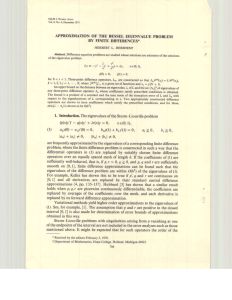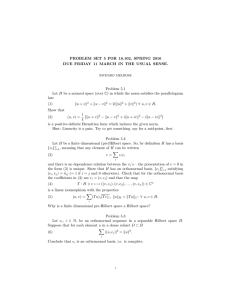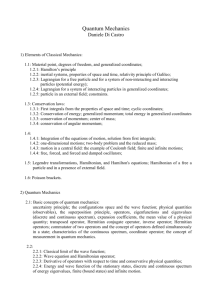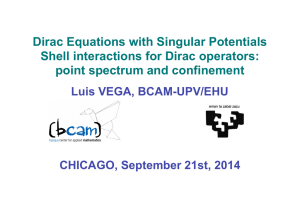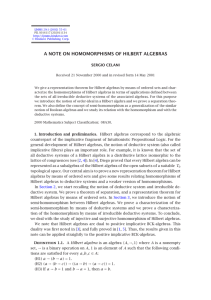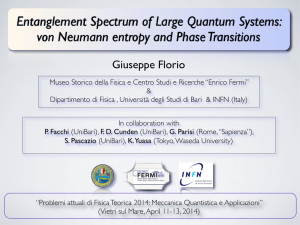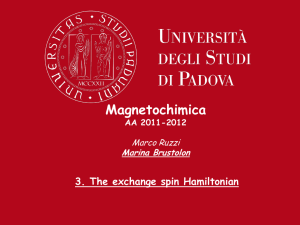Math 412-501 Theory of Partial Differential Equations Lecture 2-10: Sturm-Liouville eigenvalue
advertisement
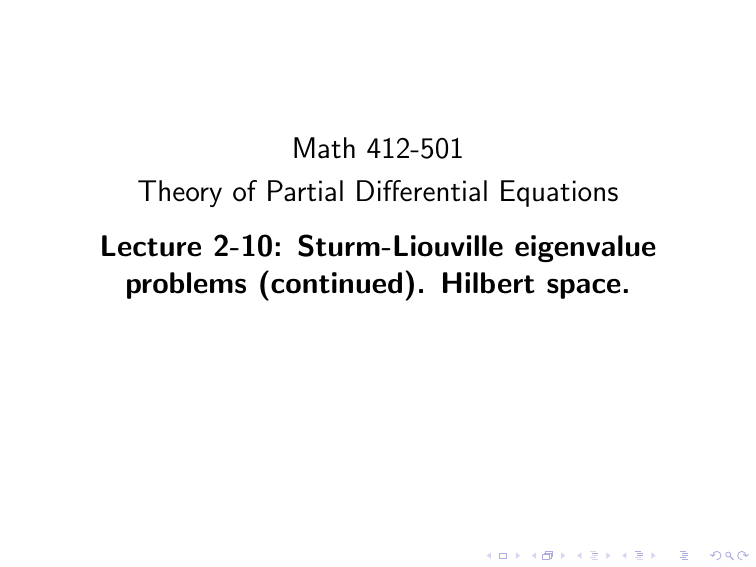
Math 412-501
Theory of Partial Differential Equations
Lecture 2-10: Sturm-Liouville eigenvalue
problems (continued). Hilbert space.
Regular Sturm-Liouville eigenvalue problem:
d dφ p
+ qφ + λσφ = 0 (a < x < b),
dx dx
β1 φ(a) + β2 φ′ (a) = 0,
β3 φ(b) + β4 φ′ (b) = 0.
Here βi ∈ R, |β1 | + |β2 | =
6 0, |β3 | + |β4 | =
6 0.
Functions p, q, σ are continuous on [a, b],
p > 0 and σ > 0 on [a, b].
6 properties of a regular Sturm-Liouville problem
• Eigenvalues are real.
• Eigenvalues form an increasing sequence.
• n-th eigenfunction has n − 1 zeros in (a, b).
• Eigenfunctions are orthogonal with weight σ.
• Eigenfunctions and eigenvalues are related
through the Rayleigh quotient.
• Piecewise smooth functions can be expanded
into generalized Fourier series of eigenfunctions.
Hilbert space
Hilbert space is an infinite-dimensional analog of
Euclidean space. One realization is
Rb
L2 [a, b] = {f : a |f (x)|2 dx < ∞}.
Inner product of functions:
Z b
f (x)g (x) dx.
hf , g i =
a
If f and g take complex values, then
Z b
f (x)g (x) dx
hf , g i =
a
so that
hf , f i =
Z
a
b
|f (x)|2 dx ≥ 0.
Norm of a function: kf k =
p
hf , f i.
Cauchy-Schwarz inequality: |hf , g i| ≤ kf k · kg k.
If f , g are real-valued, then hf , g i = kf k · kg k cos θ,
where θ is called the angle between f and g .
Convergence: we say that fn → f in the mean if
kf − fn k → 0 as n → ∞.
Lemma If fn → f in the mean then
hfn , g i → hf , g i for any g ∈ L2 [a, b].
Proof:
|hf , g i − hfn , g i| = |hf − fn , g i| ≤ kf − fn k · kg k.
Functions f , g ∈ L2 [a, b] are called orthogonal if
hf , g i = 0.
Alternative inner product:
Z b
f (x)g (x)w (x) dx,
hf , g iw =
a
where w > 0 is the weight function.
Functions f and g are called orthogonal with
weight w if hf , g iw = 0.
Alternative inner product means an alternative
model of the Hilbert space:
Rb
L2 ([a, b], w dx) = {f : a |f (x)|2 w (x) dx < ∞}.
A set f1 , f2 , . . . of pairwise orthogonal nonzero
functions is called complete if it is maximal, i.e.,
there is no nonzero function g such that hg , fn i = 0,
n = 1, 2, . . . .
A complete set forms a basis of the Hilbert space,
that is, each function g ∈ L2 [a, b] can be expanded
into a series
X∞
c n fn
g=
n=1
that converges in the mean.
Then
hg , hi =
for any h ∈ L2 [a, b].
X∞
n=1
cn hfn , hi
In particular,
hg , fm i =
X∞
n=1
cn hfn , fm i = cm hfm , fm i.
=⇒ the expansion is unique: cm =
hg , fm i
.
hfm , fm i
Also,
X∞
X∞
|cn |2 hfn , fn i.
cn hfn , g i =
hg , g i =
n=1
n=1
X∞ |hg , fn i|2
hg , g i =
n=1 hfn , fn i
(Parseval’s equality)
Suppose that f1 , f2 , . . . is an orthonormal basis,
i.e., kfn k = 1. Then
X∞
g=
cn fn , where cn = hg , fn i.
n=1
Parseval’s equality becomes kg k2 =
If h =
X∞
hg , hi =
n=1
X∞
n=1
|cn |2 .
dn fn , then
X∞ X ∞
n=1
m=1
cn dm hfn , fm i =
X∞
Which sequences c1 , c2 , . . . are allowed as
coefficients of an expansion?
n=1
cn d n .
Theorem
For any sequence c1 , c2 , . . . such that
P∞
2
n=1 |cn | < ∞, the series
X∞
c n fn
n=1
converges in the mean to some function
g ∈ L2 [a, b].
This gives rise to another model
Hilbert
P∞ of the
2
space: ℓ2 = {(c1 , c2 , . . . ) : n=1 |cn | < ∞}.
Given c = (c1 , c2 , . . . ), d = (d1 , d2 , . . . ) ∈ ℓ2 ,
the inner product is
X∞
hc, di =
cn d n .
n=1
Suppose f1 , f2 , . . . is a set of pairwise orthogonal
nonzero functions in L2 [a, b] that is not complete.
For any function g ∈ L2 [a, b], we can still compose
P∞
hg , fn i
c
f
,
where
c
=
a series
.
n
n
n
n=1
hfn , fn i
This series converges in the mean to some function
g0 ∈ L2 [a, b]. In general, g 6= g0 but g − g0 is
orthogonal to f1 , f2 , . . . .
P
Then g = ∞
n=1 cn fn + (g − g0 ) implies
P∞
P
2
2
2
kg k2 = ∞
n=1 kcn fn k .
n=1 kcn fn k + kg − g0 k ≥
X∞ |hg , fn i|2
Bessel’s inequality: hg , g i ≥
n=1 hfn , fn i
L: linear operator in the Hilbert space L2 [a, b].
In general, L is not defined on the whole space but
on a linear subspace H ⊂ L2 [a, b] which is dense.
Example. L(f ) = (pf ′ )′ + qf .
L is called self-adjoint (or symmetric) if
hL(f ), g i = hf , L(g )i for all f , g ∈ H.
If L(f ) = λf for some λ ∈ C and nonzero f ∈ H,
then λ is an eigenvalue and f is an eigenfunction.
If the operator L is self-adjoint, then
• all eigenvalues are real;
• eigenfunctions belonging to different eigenvalues
are orthogonal.
Regular Sturm-Liouville equation:
d dφ p
+ qφ + λσφ = 0 (a < x < b).
dx dx
Consider a linear differential operator
L(f ) = (pf ′ )′ + qf .
Now the equation can be rewritten as
L(φ) + λσφ = 0.
Green’s formula:
Z b
b
′
′ g L(f ) − f L(g ) dx = p(gf − fg ) a
a
If f and g satisfy the same regular boundary
conditions, then
Z b
g L(f ) − f L(g ) dx = 0.
a
That is, L is self-adjoint on the set of functions
satisfying particular boundary conditions.
L(φ) + λσφ = 0 =⇒ −σ −1 L(φ) = λφ
So eigenvalues/eigenfunctions of the Sturm-Liouville
problem are not those of operator L but those of
operator M = −σ −1 L.
The operator M is self-adjoint with respect to the
inner product h·, ·iσ .
Eigenvalue problem:
φ′′ + λφ = 0, φ(0) = φ(L) = 0.
2
Eigenvalues: λn = ( nπ
L ) , n = 1, 2, . . .
Eigenfunctions: φn (x) = sin nπx
L .
Since this is a regular Sturm-Liouville problem,
eigenfunctions form a complete orthogonal set
(a basis) in the Hilbert space L2 [0, L].
Any function f ∈ L2 [0, L] is expanded into a series
X∞
f =
cn φn
n=1
that converges in the mean.
Coefficients:
hf , φn i
2
cn =
=
hφn , φn i L
Z
L
f (x) sin
0
nπx
dx.
L
So the Fourier series always converges in the mean.
Parseval’s equality:
X∞ |hf , φn i|2 X∞
=
|cn |2 hφn , φn i.
hf , f i =
n=1
n=1 hφn , φn i
2
L
Z
0
L
2
|f (x)| dx =
X∞
n=1
|cn |2
(Parseval’s equality for Fourier sine series)
Example. f (x) = 2x, 0 ≤ x ≤ π.
X∞
4
f (x) ∼
(−1)n+1 sin nx
n=1
n
Parseval’s equality:
Z
X∞
X∞ 16
2 π
2
2
(2x) dx =
|cn | =
.
n=1
n=1 n 2
π 0
2 4π 3 X∞ 16
·
=
n=1 n 2
π 3
X∞ 1
π2
=
n=1 n 2
6
Simplicity of eigenvalues
Regular Sturm-Liouville equation:
(pφ′ )′ + qφ + λσφ = 0 (a < x < b).
Initial value problem φ(a) = C0 , φ′ (a) = C1 always
has a unique solution.
Suppose φ and ψ are eigenfunctions of a regular
problem corresponding to the same eigenvalue λ.
Then β1 φ(a) + β2 φ′ (a) = β1 ψ(a) + β2 ψ ′ (a) = 0,
where β1 , β2 ∈ R, |β1 | + |β2 | =
6 0.
It follows that (φ(a), φ′ (a)) = c(ψ(a), ψ ′ (a)), c ∈ R.
Now φ and cψ are solutions to the same initial
value problem. Hence φ = cψ.
